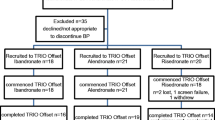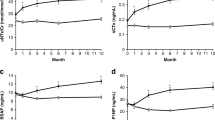Abstract:
Bisphosphonates such as etidronate and alendronate are widely accepted as effective agents for the treatment of osteoporosis. However, some physicians find the choice of which one to use in different patients, and the comparative magnitude of response, unclear. Fifty postmenopausal women with osteoporosis [group 1: 27 women who had received 3 years of previous cyclical etidronate treatment, mean age 70.5 years, bone mineral density (BMD) mean T-score lumbar spine (LS) −3.58 and femoral neck (FN) −2.51; group 2: 23 women who had not previously received cyclical etidronate treatment, mean age 73.7 years, BMD mean T-score LS −3.65 and FN −2.96] were treated with 10 mg alendronate daily, to determine whether pretreatment with etidronate affected the response to alendronate, and whether patients who did not respond to etidronate, responded to alendronate. There was a significant increase in LS BMD after 2 years of treatment with alendronate compared with baseline (group 1: 7.84%, p<0.001; group 2: 6.69%, p<0.001), but there was no statistical difference between the groups. In the group 1 patients there was a significant difference between the initial response (at the LS BMD) to 2 years of cyclical etidronate (1.86%) and later response to 2 years of alendronate (7.84%) (p<0.0001). The 10 patients who did not respond at the LS to etidronate alone, showed a significantly better response (mean BMD change +6.3%) when subsequently treated with alendronate (a net difference of 9.3%, p = 0.002). In 15 patients who did not respond at the FN to etidronate alone, the mean response to alendronate was +0.96% (a difference of 7%, p = 0.004). This study shows that pretreatment with 3 years of cyclical etidronate is not detrimental to the subsequent LS BMD response to alendronate. There is evidence that alendronate produced a greater bone density response than etidronate, and patients who did not respond to etidronate with an increase in LS bone density, subsequently did so following alendronate.
Similar content being viewed by others
Author information
Authors and Affiliations
Additional information
Received: 22 June 1999 / Accepted: 18 January 2000
Rights and permissions
About this article
Cite this article
Fairney, A., Kyd, P., Thomas, E. et al. Response to Alendronate in Osteoporosis after Previous Treatment with Etidronate . Osteoporos Int 11, 621–625 (2000). https://doi.org/10.1007/s001980070084
Issue Date:
DOI: https://doi.org/10.1007/s001980070084




